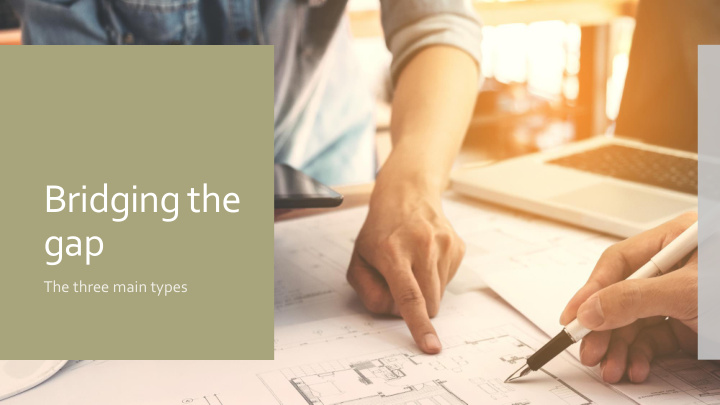



Bridging the gap The three main types
The names of the three main types of bridge are: BEAM ARCH SUSPENSION
Your objectives are to Understand the Have an idea of differences what type of between the bridge you want to bridge types build Understand the Understand impacts bridges considerations by have on engineers when communities building bridges
What have you noticed about bridges? How many do you use every day? What bridges stand out for you? Why is a bridge important to you?
Recognition for bridges! Most bridges you use are just considered a part of the road system. But they are so much more than that! 1. Contribute heavily to social lives 2. Increases impact on local businesses 3. Impact upon environmental development
Unique bridges
History of bridges • Some of the earliest bridges were just fallen trees or logs that were positioned over small rivers and ravines (natural bridges) • Later, bridges were made of rope and wooden boards. This type of bridge allowed for transporting materials on carts and wagons. Heavy loads were an issue however, and severe weather • Stone arch bridges came later with the Roman Empire, and even now many Roman built bridges are still being used across the world
Arch bridges are built on top of a wooden frame. This allows the stones to be put in place. The stone in the middle of the bridge is called the keystone and is the most important part, without this, the arch would collapse. When the keystone is put in place, the wooden frame can be removed. keystone
An arch bridge is always under compression. It works because instead of pushing straight down, the load of an arch bridge is carried out along the curve of the arch to the supports at each end. These supports are called the abutments and they carry the load and stop the ends of the bridge from spreading out. keystone abutments
How does it work? The weight from the load at the top of the keystone makes each stone on the arch of the bridge press on ( compress ) the one next to it. This happens until the force reaches the end abutments which are built into the ground.
The ground around the abutments is squeezed and pushes back on the abutments.
The ground pushes back on the abutments and passes the force back up from stone to stone, until it is back pushing on the keystone which supports the load.
Simplest kind of bridge. Can simply consist of horizontal beam supported at each end by pillars. Must be stiff – resists twisting or bending under load. Normally cover short distances. Longer = weaker.
It is just one beam that stretches across a gap in the landscape and is supported by columns. column
The weight of the beam pushes straight down onto the columns but the beam needs to be able to support the weight of the loads when they are between the columns. The further apart the columns are, the stronger the beam needs to be. For this reason, the beam bridge is usually used to span shorter distances. column beam
To make a longer beam bridge, engineers can do a few things e.g. join a few beam bridges together or use trusses. trusses
Can you spot any keystones or abutments on these arch bridges?
Originally made from rope and wood. Strong and lightweight. Most expensive type of bridge to build. Suspend the roadway from huge main cables. Cables extend from one end to other. Cables rest of high towers and must be secure. Built to cover long distances. Most famous and beautiful bridges. Weight of bridge is distributed safely and evenly.
Now try this game on the iPads! http://www.pbs.org/wgbh/buildingbig/bridge/challenge/indexp.html?l
Each person will have to construct a bridge design of their choice, but it must meet the following criteria: • It must not be over 40cm long, and be able to cope with increasing weight without being supported to the side (allow for 5cm either side to rest on blocks) Your • The bridge is not allowed to be more than 30cm high • The inside width of the bridge must be no more than one Challenge! 15cm wide Bonus marks for: Design – building based on a particular bridge type – independence – creativity
Consider your resource pack before designing Which type of bridge will you build? Are you going for style or stability? Your first task, is to sketch out your plan onto the planning sheet! • Consider the resources in your pack before making any final decisions! Doesn’t this one look amazing!
Consider the key areas outlined above to ensure you score the highest rating from your teacher!
Recommend
More recommend